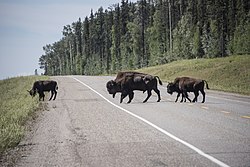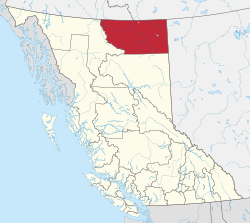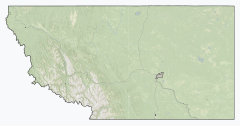Northern Rockies Regional Municipality
The Northern Rockies Regional Municipality (NRRM), formerly the Northern Rockies Regional District (NRRD),[6] and before that the Fort Nelson–Liard Regional District, is a municipality in northeastern British Columbia, Canada. Although portrayed as a regional municipality in its official name, and existing on the same administrative level as a regional district, it is actually classified as a district municipality.[1] The NRRM's offices are located in Fort Nelson, formerly an incorporated town that amalgamated with the NRRD on February 6, 2009, to form the NRRM.[7][8] With the Peace River Regional District as the southern part, it was the northern part of the Peace River-Liard Regional District, which was split into two on October 31, 1987.
Northern Rockies | |
|---|---|
| Northern Rockies Regional Municipality[2] | |
 Bison on the Alaska Highway | |
Major communities | |
 Location in British Columbia | |
| Country | Canada |
| Province | British Columbia |
| District municipality[1] | February 6, 2009 |
| Administrative office | Fort Nelson |
| Government | |
| • Type | District municipality |
| • Mayor | Rob Fraser |
| • Councillors | List
|
| Area (2011)[3] | |
| • Total | 85,014.52 km2 (32,824.29 sq mi) |
| Population (2021)[4] | |
| • Total | 4,478 |
| • Density | 0.053/km2 (0.14/sq mi) |
| Time zone | UTC-7 (Mountain[5]) |
| • Summer (DST) | UTC-7 (not observed) |
| Area code | 250 |
| Website | www |
The NRRM lies on the east slope of the Rocky Mountains, and comprises approximately 10% of the total area of the province of British Columbia, encompassing 85,014.52 square kilometres (32,824.29 sq mi).[3] Its southern boundary is the 58th parallel of latitude[6] and is bisected by the Alaska Highway from its southeast to its northwest. The Northern Rockies Regional Municipality is primarily made up of heavily forested areas and mountainous terrain.
The Northern Rockies Regional Municipality is the first of its kind in British Columbia in which an entire former regional district is governed and headed by a single municipal government. Its council comprises a mayor and six councillors. Bill Streeper was the NRRM's first mayor.
Communities
editFort Nelson
editWith a 2016 population of 3,366,[9] Fort Nelson is the largest community in the Northern Rockies Regional Municipality. All of the NRRM's offices and officials are based out of Fort Nelson.
Fort Nelson First Nation
editFort Nelson First Nation is an aboriginal band situated directly outside of the town of Fort Nelson and a signatory nation of Treaty 8. The reserve is home to about 700 residents, making Fort Nelson First Nation one of the largest reservations in northern British Columbia. Dene and Cree are the most prevalent Aboriginal Canadian backgrounds found on the Fort Nelson First Nation reserve. The nation works closely with oil and gas producers to ensure safe and sustainable development in the Horn River Basin based on the fact that much of the new development in the Horn River Basin is occurring on traditional Fort Nelson First Nation land. The band operates Echo-Dene and the Liard Hot Springs lodge, as well as Chalo School, a kindergarten to grade twelve accredited educational institution. Liz Logan is the Chief Councillor of the Fort Nelson First Nation, reelected in August 2014. The FNFN Band Council consists of seven councillors, an increase from six. The chosen councillors then decided amongst themselves the Chief Councillor.[10][11]
Prophet River First Nation
editThe Prophet River First Nation is the southernmost community in the Northern Rockies Regional Municipality. Prophet River's main industries revolve around commercial services and provisions to the local and nearby oil and gas industry. Lynette Tsakoza is currently the chief of Prophet River First Nation which is a member of the Treaty 8 Tribal Association.[12]
Tetsa River
editTetsa River is a small community based on the Alaska Highway that is known for its eco-tourism and camping. Fishing, rafting, hunting, and other eco-tourism related activities are commonly practiced recreational attractants to the region. Tetsa River offers a popular fishing derby every August, in which residents from all over the region compete.
Toad River
editToad River is the largest regional community north of Fort Nelson in terms of population. The community is home to a highway maintenance camp, a small school accredited by the region's school district (School District 81), a community hall, two campgrounds, and two lodges. Toad River's economy relies primarily on tourism, and is a popular destination for travellers on the Alaska Highway.
Muncho Lake
editMuncho Lake is a community that is situated on the Muncho Lake Provincial Park. The park is known for its blue-coloured lake which attracts tourists to the area every year. Muncho Lake is situated on the Alaska Highway.
Demographics
editIn the 2021 Census of Population conducted by Statistics Canada, Northern Rockies had a population of 3,947 living in 1,692 of its 2,268 total private dwellings, a change of -18.8% from its 2016 population of 4,862. With a land area of 84,759.31 km2 (32,725.75 sq mi), it had a population density of 0.0/km2 (0.1/sq mi) in 2021.[13]
As a census division in the 2021 census, Northern Rockies had a population of 4,478 living in 1,918 of its 2,523 total private dwellings, a change of -17% from its 2016 population of 5,393. With a land area of 84,858.88 km2 (32,764.20 sq mi), it had a population density of 0.1/km2 (0.1/sq mi) in 2021.[14]
Ethnicity
edit| Panethnic group |
2021[4] | 2016[15] | 2011[16] | 2006[17] | 2001[18] | 1996[19] | ||||||
|---|---|---|---|---|---|---|---|---|---|---|---|---|
| Pop. | % | Pop. | % | Pop. | % | Pop. | % | Pop. | % | Pop. | % | |
| European[a] | 2,670 | 60.75% | 3,465 | 65.44% | 4,080 | 73.51% | 4,610 | 75.51% | 4,620 | 80.91% | 4,830 | 82.49% |
| Indigenous | 1,410 | 32.08% | 1,485 | 28.05% | 1,235 | 22.25% | 1,185 | 19.41% | 1,050 | 18.39% | 890 | 15.2% |
| Southeast Asian[b] | 130 | 2.96% | 210 | 3.97% | 50 | 0.9% | 75 | 1.23% | 15 | 0.26% | 0 | 0% |
| South Asian | 70 | 1.59% | 30 | 0.57% | 145 | 2.61% | 155 | 2.54% | 0 | 0% | 30 | 0.51% |
| African | 50 | 1.14% | 35 | 0.66% | 0 | 0% | 50 | 0.82% | 10 | 0.18% | 0 | 0% |
| East Asian[c] | 40 | 0.91% | 45 | 0.85% | 0 | 0% | 20 | 0.33% | 0 | 0% | 65 | 1.11% |
| Latin American | 0 | 0% | 10 | 0.19% | 0 | 0% | 0 | 0% | 20 | 0.35% | 25 | 0.43% |
| Middle Eastern[d] | 0 | 0% | 0 | 0% | 0 | 0% | 0 | 0% | 0 | 0% | 0 | 0% |
| Other[e] | 0 | 0% | 25 | 0.47% | 15 | 0.27% | 0 | 0% | 0 | 0% | 0 | 0% |
| Total responses | 4,395 | 98.15% | 5,295 | 98.18% | 5,550 | 99.5% | 6,105 | 99.32% | 5,710 | 99.83% | 5,855 | 99.98% |
| Total population | 4,478 | 100% | 5,393 | 100% | 5,578 | 100% | 6,147 | 100% | 5,720 | 100% | 5,856 | 100% |
- Note: Totals greater than 100% due to multiple origin responses.
Religion
editAccording to the 2021 census, religious groups in the Northern Rockies Regional Municipality included:[4]
- Irreligion (2,300 persons or 59.5%)
- Christianity (1,460 persons or 37.8%)
- Sikhism (40 persons or 1.0%)
- Other (30 persons or 0.8%)
References and notes
edit- ^ Statistic includes all persons that did not make up part of a visible minority or an indigenous identity.
- ^ Statistic includes total responses of "Filipino" and "Southeast Asian" under visible minority section on census.
- ^ Statistic includes total responses of "Chinese", "Korean", and "Japanese" under visible minority section on census.
- ^ Statistic includes total responses of "West Asian" and "Arab" under visible minority section on census.
- ^ Statistic includes total responses of "Visible minority, n.i.e." and "Multiple visible minorities" under visible minority section on census.
- ^ a b c "Order of the Lieutenant Governor in Council (Order in Council No. 033)" (PDF). Province of British Columbia. January 29, 2009. p. 3. Retrieved September 20, 2014.
The class of the municipality is a district municipality.
- ^ "British Columbia Regional Districts, Municipalities, Corporate Name, Date of Incorporation and Postal Address" (XLS). British Columbia Ministry of Communities, Sport and Cultural Development. Retrieved November 2, 2014.
- ^ a b "Population and dwelling counts, for Canada, provinces and territories, and census subdivisions (municipalities), 2011 and 2006 censuses (British Columbia)". Statistics Canada. January 30, 2013. Retrieved June 15, 2013.
- ^ a b c Government of Canada, Statistics Canada (October 26, 2022). "Census Profile, 2021 Census of Population". www12.statcan.gc.ca. Retrieved November 11, 2022.
- ^ New Time Zone in Fort Nelson, timeanddate.com, 21 September 2015.
- ^ a b "Northern Rockies Regional Municipality". BC Geographical Names.
- ^ "Fort Nelson". Northern Rockies Regional Municipality. Archived from the original on August 14, 2012. Retrieved December 6, 2012.
- ^ "Statistics Relating to Regional and Municipal Governments in BC 2011" (PDF). British Columbia Ministry of Community, Sport and Cultural Development. p. 21 of 30. Retrieved December 6, 2012.
- ^ "Fort Nelson [Population centre], British Columbia and British Columbia [Province]". statcan. Statistics Canada. Retrieved August 28, 2018.
- ^ "Fort Nelson First Nation". Fort Nelson First Nation. Retrieved June 19, 2012.
- ^ "Home". fortnelsonfirstnation.org.
- ^ "Treaty 8". Treaty 8 Tribal Association. Retrieved June 19, 2012.
- ^ "Population and dwelling counts: Canada, provinces and territories, and census subdivisions (municipalities), British Columbia". Statistics Canada. February 9, 2022. Retrieved February 20, 2022.
- ^ "Population and dwelling counts: Canada and census divisions". Statistics Canada. February 9, 2022. Retrieved April 3, 2022.
- ^ Government of Canada, Statistics Canada (October 27, 2021). "Census Profile, 2016 Census". www12.statcan.gc.ca. Retrieved February 23, 2023.
- ^ Government of Canada, Statistics Canada (November 27, 2015). "NHS Profile". www12.statcan.gc.ca. Retrieved February 23, 2023.
- ^ Government of Canada, Statistics Canada (August 20, 2019). "2006 Community Profiles". www12.statcan.gc.ca. Retrieved February 23, 2023.
- ^ Government of Canada, Statistics Canada (July 2, 2019). "2001 Community Profiles". www12.statcan.gc.ca. Retrieved February 23, 2023.
- ^ Government of Canada, Statistics Canada (June 4, 2019). "Electronic Area Profiles Profile of Census Divisions and Subdivisions, 1996 Census". www12.statcan.gc.ca. Retrieved February 23, 2023.


